Emergency and Safety Information
It is important that students, faculty, staff, and others affiliated with Electrical and Computer Engineering (ECE) are aware of the campus and building safety policies and procedures in case of an emergency.
ECE has a detailed emergency action plan (PDF) that adheres to College of Engineering’s requirements.
Emergency contact information
In the event of an emergency, get to a safe area and dial 911. If you are not calling from a campus phone, you must identify that you are calling from the University of Michigan Campus. Then provide the operator with your location and state the emergency.
To report activity or behavior that seems suspicious or of concern, or for non emergent needs, contact Division of Public Safety and Security ↗ (DPSS) at (734) 763-1131.
For more information on workplace emergencies and for resources that can help people who are distressed or disruptive, please see the U-M Workplace Emergencies ↗ page.
Building emergencies
If you encounter an emergency building situation (flooding, toilet room issues, electrical issues, etc.), you should contact Plant Operations at 647-2059. They will take the information (building, room, issue, your name, etc.) and get the appropriate personnel out to EECS asap. Plant operations will give you a work order number. Please take that number and send it to ECE facilities staff at: [email protected].
Please don’t delay! Call Plant Operations first, and then any other staff you feel should know.
How to react in an emergency
Active attacker
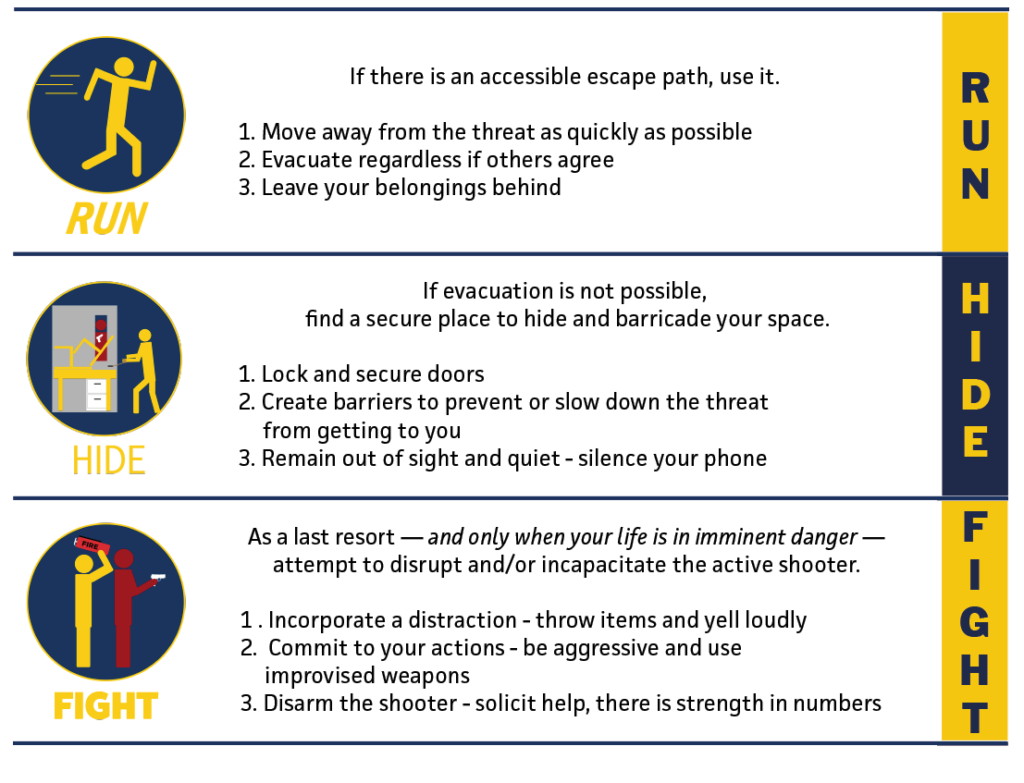
Run, Hide, Fight. Have an escape route and attempt to evacuate. Evacuate even if others disagree and leave your belongings. If you can’t leave, hide and be prepared to fight.For important detailed information on how you should react during and after an active attacker incident, visit the Division of Public Safety and Security (DPSS) ↗ website and see the video below.
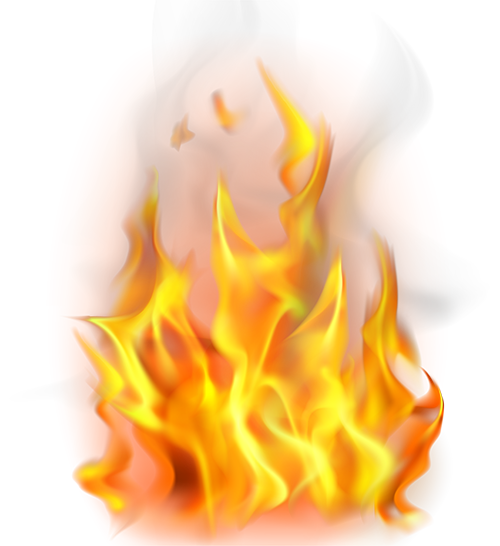 Fire
Fire
If you notice smoke or fire call 911 and activitate the building’s fire alarm. In case of a fire, all building occupants should immediately make their way toward the nearest exit and adhere to the following procedures:
- Remain calm.
- Move quickly and calmly to the nearest emergency exit.
- Close doors and leave them unlocked, if possible.
- Do not use elevators.
- Move to designated assembly areas.
- Do not congregate in the entrances to buildings, keep them clear
- Keep class together and take attendance to ensure all students have exited the building.
- Those with disabilities, if possible, move to the northwest stairwell of EECS and the fire personnel will assist your exit from the building.
Where to assemble
If you are in the EECS or GGB building, congregate in the main parking lot on Hayward Street on the north side of the building or in the Gerstacker Grove on the east, away from the building. If you are in the ERB/Gerstacker Complex, congregate to the East in the parking lot or to the north on the median strip of Bonisteel Ave. Do not block fire lanes.
Do not return to the building until an official all clear is given by authorities.
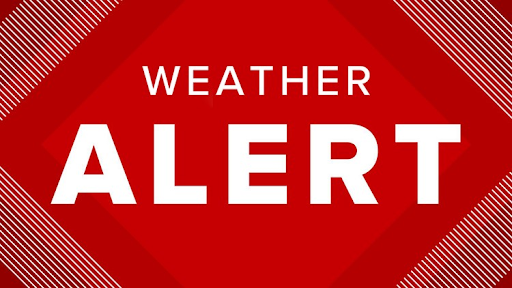 Weather Alerts
Weather Alerts
Severe weather includes inclement weather during which there is a severe weather warning. All active students, faculty and staff with a U-M email address are automatically registered to receive notifications from the U-M Emergency Alert ↗ system.
You should know the difference between a severe weather watch and warning ↗. Whenever severe weather is forecast, move to a safe indoor location. Go immediately to one of the designated shelter areas: Classrooms 1003 and 1005 w/overflow into corridors 10C1, 11C0 & 11C1 for EECS; BC12, BC14, BC20, BC21 for ERBI and ERBII; Room 1371 & corridor 1200H (Civil wing) & 13C1, 13C5 GGB; and Corridors 1C04 & 1C05 of Gerstacker.
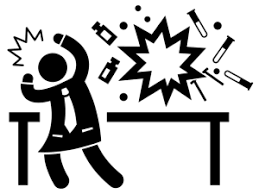 Lab Incidents
Lab Incidents
The best way to prevent a lab accident is to be prepared and knowledgeable. Having a good comprehension of the type of equipment, chemical or biological material you will be working with and their potential hazards is called a “working understanding” of your environment.
Please familiarize yourself with your Chemical Hygiene Plan and other best practices and lab safety information found at the Environmental Health and Safety (EHS) website ↗.
For lab emergencies contact 911 and/or EHS 647-1143. All incidents must be reported, see section on incident reporting below.
Watch these videos for what can happen when you don’t follow proper procedures:
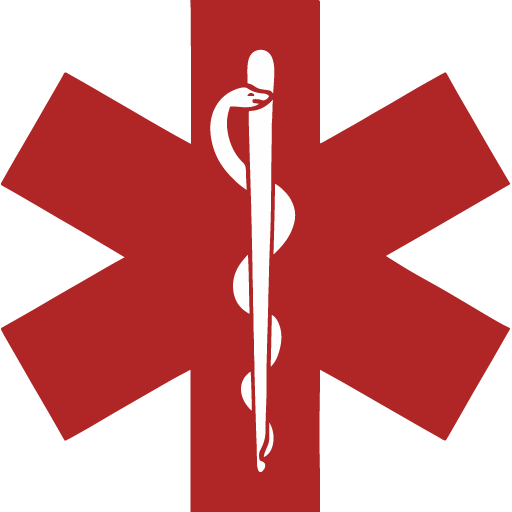 Serious injury or medical emergency
Serious injury or medical emergency
If you believe emergency medical attention may be needed, call 911 immediately and provide the following information:
- Location of the incident or the injured parties
- Nature of the injury, cause and severity
- Victim’s age and name, if known
- Any known medical information
If possible, a designated person should meet emergency responders at some easily accessible location outside the building and escort them to the person who needs medical help.
While awaiting emergency response:
- Keep the victim(s) calm and reassured that help is on the way
- Do not attempt to treat or move the victim(s) if you are not formally trained in first aid
- Be careful if you come in contact with blood or other body fluids—they may be infectious
- Stay with emergency responders until released
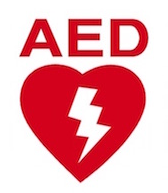 AEDs for cardiac arrest
AEDs for cardiac arrest
In the case of a sudden cardiac arrest, proper use of an Automated Electronic Defibrillator (AED) device can greatly increase the chance of survival.
Red AEDs are located in the following locations
- EECS Building: on each floor near the elevators
- ERBII: near the exit and near room 231 in the basement; near room 1235 on the 1st floor
- ERBI: to the west of the elevators on the 1st floor and near the elevators and on the 4th and 6th floors
- GG Brown Building: near room 3605 and opposite the freight elevator
- Gerstacker Building: on the first floor near the main entrance door, as well as near the east stairwell on the second floor.
To review how to use an AED, see this information on the Red Cross website ↗ or watch this short video for correct usage ↗.
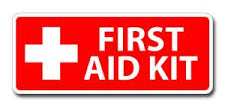 First aid & non-life threatening injury or illness
First aid & non-life threatening injury or illness
First aid kits can be found at the EECS dock (1421 EECS) and in the Chair’s Suite (3310 EECS) and in 6113 ERBI.
For non-life threatening injury or illness, go to:
EECS Safety Contact Information
To make suggestions or to report non-emergency safety concerns, please contact any of the following.
Facilities Coordinator
Michael Lee
3302 EECS
[email protected]
734-763-9756
ECE Department Manager
Lisa Armstrong
3309 EECS
[email protected]
734-936-0647
ECE Safety Committee
After incident reporting
All safety related incidents (accidental injury, violence, disasters, medical emergencies, and security threats) occurring within College of Engineering facilities must be reported to the College of Engineering Safety Committee using the CoE Safety Incident Report ↗.
Please also inform the ECE Safety Committee ([email protected]), providing the information submitted on the CoE Safety Incident ↗ Report, for review at the subsequent ECE Safety Committee.
 Indoor drone use policy
Indoor drone use policy
According to University of Michigan policy ↗, indoor use of a drone or Unmanned Aircraft System (UAS) on UM property does not require an application or waiver, but may only occur in a University space or building that has established policies and procedures to permit the safe operation of drones, and only with written permission from the both the building manager (Paula Pernia) and unit administrator (Lisa Armstrong).
The following constitutes the EECS Building Best Practices document in regards to safe operation of drones inside EECS. This policy pertains to research-, teaching-, and ECE camp-related drone flight only. Personal drone flight is not allowed in the building.
- ECE requires groups to reserve the EECS Atrium through contacting the college directly for use during the drone flight. A faculty experienced with UAS (Unmanned Aircraft System) must supervise the flight operation.
- The drone must be flown in the designated tent following the design by the ECE Safety Committee.
- Egress signs must be posted on tent.
- UAS free flight is not allowed in the EECS building. UAS’s should not be flown in hallways or gathering areas of EECS.
- Eye protection must be worn by people within the tent.
- No minor can operate any drone without the direct attention and proximity of a qualified and designated supervising adult.
- Faculty using drones during high school summer camps held in ECE are required to adhere to the requirements for “heavier multicopters” for the safety of minors attending the camps.
- Individual faculty are responsible for ensuring the safety of any flight occurring strictly in their research or instructional labs.
- Anyone seeking to fly a drone outdoors must work with the University of Michigan Institutional Autonomous Systems Committee (IASC) to gain proper authorization
- For additional information about drone usage see https://research.umich.edu/unmanned-aircraft-systems ↗
Additional Safety Information
For more information about safety and security at the College of Engineering, please visit the College of Engineering Safety website.
For more information on safety and education tips please visit The Divisor on Public Safety and Security DPSS ↗
 MENU
MENU 
